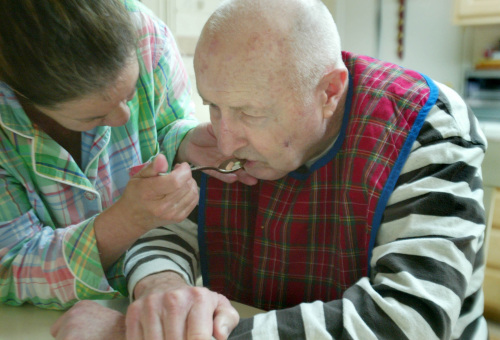Alzheimer's disease may be passed down from ailing mothers, study suggests
By 이우영Published : March 2, 2011 - 10:37
Mothers may be more likely to pass down Alzheimer’s disease to their children than fathers, a finding that may help identify patients earlier, researchers from the University of Kansas School of Medicine said.
Healthy older adults with no cognitive problems whose mothers had Alzheimer’s disease had more brain shrinkage than those who had a father or no parent with the disease, according to research published today in the journal Neurology.
About 5.3 million Americans have Alzheimer’s disease and the number may increase to as much as 16 million by 2050, according to the Alzheimer’s Association. Age and family history are the two biggest risk factors for developing the disease, the researchers said. Today’s study provides more details on the biology behind the disease, study author Jeffrey Burns said.

“Our data is another piece to this puzzle that suggests that maternal inheritance is more important than paternal,” said Burns, director of the Alzheimer and Memory Program at the University of Kansas Medical Center in Kansas City, in a Feb. 25 telephone interview. “It appears that maternal factors might be imparting some risk that we don’t see coming from paternal or lack of family history.”
Researchers analyzed 53 people ages 60 and older who had no signs of dementia. Of those, 11 had mothers with the disease and 10 had fathers with the condition. They then were given brain scans and cognitive tests over the two-year study.
Study Results
The brain’s gray matter, which is part of nerve cells responsible for processing signals, shrank twice as much over the two years in study participants who reported their mothers had Alzheimer’s compared with those who had a father with the disease or no family history of the illness, the researchers said. Those whose mothers had the condition also saw the size of their brains decrease more than those whose fathers had the disease, according to the researchers.
Brain atrophy, or shrinkage of the brain, occurs in Alzheimer’s disease, the researchers said.
Whether those in the study will develop Alzheimer’s disease remains to be seen, Burns said. The researchers are continuing to follow the participants. Also, larger studies are needed to replicate these findings, he said.
People whose mothers have Alzheimer’s shouldn’t panic after reading these results, said Marc L. Gordon, a neurologist and Alzheimer’s researcher at the Feinstein Institute for Medical Research in Manhasset, New York.
“It’s very important to recognize a risk factor is not the same thing as being absolutely certain someone will get the disease,” Gordon, who wasn’t an author on today’s paper, said in a Feb. 25 telephone interview. “It’s an increased risk but it doesn’t mean you will certainly get this.”
The study was funded by the U.S. National Institutes of Health.
(Bloomberg)
<한글 기사>
치매는 모계 유전(?)
노인성 치매(알츠하이머병)는 부계보다는 모계 유전 가능성이 더 높다는 연구결과가 나왔다.
미국 캔자스 대학 메디컬센터 신경과전문의 제프리 번스(Jeffrey Burns) 박사는 어머니가 치매환자였던 사람은 아버지가 치매를 겪었던 사람에 비해 치매와 관련된 핵심 뇌부위가 위축될 가능성이 크다고 밝힌 것으로 헬스데이 뉴스가 28일 보도했다.
번스 박사는 어머니가 치매환자였던 11명, 아버지가 치매환자였던 10명, 부모가 어느쪽도 치매를 겪지 않은 32명 등 60세 이상 노인 53명을 대상으로 화소기반 형태 분석법(VBM)을 이용해 3차원 뇌지도를 작성한 결과 치매 모친 그룹이 치매 부친 그룹과 정상부모 그룹에 비해 치매와 관련된 핵심 뇌부위인 해마옆이랑(parahippocamp al gyrus)과 설전부(precuneus)의 회색질이 2배나 위축된 것으로 나타났다고 밝혔다.
회색질은 대뇌의 겉부분으로 신경세포들이 모여있으며 회백색을 띠고 있어 회색 질이라고 불린다. 신경돌기들이 모여있는 속부분은 하얀 색이어서 백질(white matte r)이라고 한다.
치매 모친 그룹은 또 치매 부친 그룹과 정상부모 그룹에 비해 뇌의 전체 용적(brain volume)이 1.5배 더 손실돼 있는 것으로 나타났다.
노인들은 매년 뇌가 조금씩 위축되는 게 보통이고 이것이 꼭 치매의 신호라고는 할 수 없지만 치매 환자의 경우 뇌의 위축 속도가 훨씬 빠르다.
번스 박사는 이 결과는 치매가 부계보다는 모계 유전 가능성이 크다는 사실을 보여주는 것이며 그 이유는 세포 활동에 필요한 에너지를 공급하는 세포 안의 발전소인 미토콘드리아의 기능장애와 연관이 있을 것으로 생각된다고 말했다.
미토콘드리아는 오직 모계를 통해 유전된다.
미토콘드리아의 문제가 치매와 연관이 있다는 연구결과도 앞서 발표된 일이 있다고 번스 박사는 지적했다.
이 연구결과는 '신경학(Neurology)' 최신호(3월1일자)에 발표됐다.
(연합뉴스)








![[Kim Seong-kon] Democracy and the future of South Korea](http://res.heraldm.com/phpwas/restmb_idxmake.php?idx=644&simg=/content/image/2024/04/16/20240416050802_0.jpg&u=)







![[KH Explains] Hyundai's full hybrid edge to pay off amid slow transition to pure EVs](http://res.heraldm.com/phpwas/restmb_idxmake.php?idx=652&simg=/content/image/2024/04/18/20240418050645_0.jpg&u=20240418181020)

![[Today’s K-pop] Zico drops snippet of collaboration with Jennie](http://res.heraldm.com/phpwas/restmb_idxmake.php?idx=642&simg=/content/image/2024/04/18/20240418050702_0.jpg&u=)